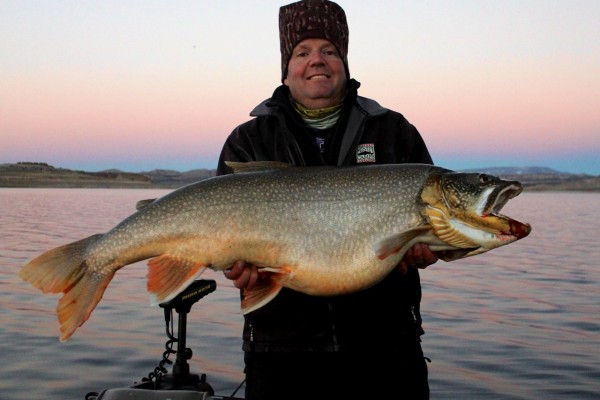
The best of the trip was this bruiser 38 LB. laker from Flaming Gorge. Mike and his buddies caught a total of 36 lake trout in a few days!!
Click to view image
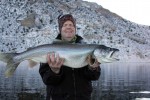
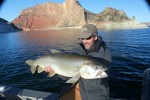

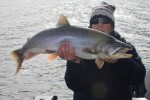


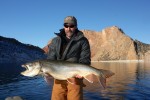
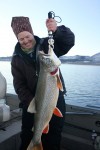

Those that know me have long known that I have a deeply rooted passion to
catch giant fish of all species. Being a native of the Colorado’s mountains is where
one finds my deepest roots of all, which is in the pursuit of giant trout. I have
literally spent the last 40 years of my “free time” life dedicated to learning how to
consistently catch behemoth trout of all the species. The lake trout or “Laker” has
a special place in my fishing passions, as it was the one fish that grew excessively
large in the neighboring lakes of my hometown. From an early age, it was my target
I also came to learn at a very early age that these monsters do not come easily, but
as time and experience have passed, they now seem to come with a great deal of
consistency. After this year, I have now logged more than 200 Lakers over the 20-
pound mark from the lower 48, though I only fish for Lakers one or two times a
In the lower 48, there are two incredible lake trout lakes that I now focus my
attention when time allows. One is Blue Mesa, one of the largest reservoirs in
Colorado and home to the state record lake trout. The other is the even larger
Flaming Gorge Reservoir, or the Gorge, which is slightly beyond the borders of my
home state, but is literally the closer of the two to reach.
Both of these waters have produced a lake trout over the coveted 40-pound size
for me, along with many others that were slightly smaller. All were caught on light
tackle with Jigs. Of the two lakes, Blue Mesa is much less consistent from year to
year, but Flaming Gorge has produced trophies with incredible consistency since the
first time I fished this lake in the late fall of 1989. Since that first trip to the Gorge,
I have been able to fish this lake all but a couple of years, and usually came back
satisfied from a good trip (defined as at least one Laker over 20 pounds) to a great
trip (defined as 2 or more Lakers over 30-pounds).
Over these years, a couple of dedicated fishing friends (Chris and Mike) and I have
decided to do whatever is possible to have an annual fishing trip to the fabled Gorge.
As we wind our year down, it is a wonderful way to spend time with great friends
that share a similar passion and catch up on our different lives from the previous
year. In planning our trip, I have learned that the number one key to success is to
have compatible weather. For jigging, this is most critical!
When jigging, the weather must allow for one to hold the boat in place, suspended
over lake trout that are typically located on underwater structure that is located
between 30 and 100 feet of water. We have learned to never use an anchor, as
we found that these fish can be incredibly spooky, a result from people fishing
over them nearly 300 days each year. I remember on one of my first trips to the
Gorge where we spotted a group of fish on the sonar in 95 feet of water. As we
dropped our jigs down to the fish, we could watch them swim up toward the jigs
when they were only 15-feet under the boat. If a fish can detect a ½ ounce jig from
that depth, they can certainly tell when a 20-foot boat is above them. Our electric
trolling motor can hold us in place when the wind blows to about 10-mph and the
occasional gust that exceeds this speed. However, if the wind blows beyond this,
we wind up going back to the hotel and watching football. Obviously, the perfect
wind is none at all, and those trips where I have had calm waters have consistently
yielded higher numbers of truly big fish.
Today, the ability to predict weather from about three to four days out is with high
probability, and this year, our original trip was to be the week before Thanksgiving,
but a strong front was predicted and we knew that we would not be able to fish
using out favorite jigging techniques. So we moved to the week of Thanksgiving and
the long-term forecast showed a very stable pressure system and calm winds. This
would be perfect and we were all able to convince our respective families to allow
us one more fishing fix for the year. Chris would bring his boat and he and Mike
would travel to the Gorge from the South, while I would head North to I-80 and then
head West, with the rendezvous at the Lucerne Valley Marina, the morning after
Thanksgiving.
In preparation for winter lake trout at the Gorge, I rig up two rods. One rod is an 8-
foot spinning rod of medium to light action. The spinning reel is spooled with 15-
pound test Power Pro line. I then add another eight to ten feet of eight-pound test
monofilament to which I attach my jig. This rod is used to cast jigs as we have found
this is one of the best methods to catch big lake trout when the water is completely
calm. The other rod is a light action bait-casting rod with an ultra-light reel. This
reel is spooled with extra-limp monofilament line. This rod works well when fishing
directly under the boat. We have also learned that the cold mornings will freeze
most forms of spectra type lines to the reels, making casting and strike detection
difficult, but mono-line never freezes to the spools, even if the temperatures dip
below zero degrees.
As for jigs, we tie our own, but they are quite simple. They are made of marabou
and tied with red Kevlar thread. The marabou is far more lifelike than any gitzet
jig and present a different look to the fish, as 99 percent of all jigging is now done
with gitzets. As I mentioned earlier, these fish are smart, and we have found small
changes make a big difference with respect to success. Our jig sizes are typically ¼
to ¾ ounce round head jigs that are painted with gloss paint that matches the color
of the marabou. The bodies of the jigs are simply an entire marabou feather on the
top and one on the bottom. Colors do not seem to matter as much as presentation,
but white and green are still my go to colors.
Day 1 - With rods rigged with my favorite jigs, we converged at daybreak and
prepared for the day of fishing. The weather was perfect, clear skies, no moon, and
most important, glass calm waters. It was very cold, with a morning temperature of
10 degrees, so we dressed up in our many layers of clothes and Sorrel boots. Chris
had replaced all of his electronics with new equipment on his boat and so we knew
we would have a few hours of electronics learning curve ahead of us. I decided I
would take the controls of the boat and its equipment, and learn its necessities while
parked over one of my favorite underwater points south of Lucerne marina.
Upon arrival of our first point, the fish were right where they were supposed to
be, located within five feet of the bottom in 45-55 feet of water. Chris and Mike
dropped the jigs down to the bottom and began to work them through the marked
fish that were on the graph. It took about 30 minutes before the first strike came,
but when it did, Chris was into the first fish of the trip. The fish was large and after
about 10-minutes the first fish was at the side of the boat. It was then that we
realized we forgot a key piece of equipment, the net. We quickly improvised and I
pulled out my Boga Grip and was still able to land the nice sized Laker. The fish was
between 15 and 20 pounds and worthy of a couple of pictures to kick off success.
After the release of Chris’s fish, I was now antsy to fish, and we were still marking
good fish around our boat. It took another hour before I hooked up, landing a
similar sized fish to Chris’s. We continued to fish the spot and hooked a couple of
small fish, but the lake trout seemed to be onto us, so we moved to other spots.
We tried several of our favorite humps and marked fish over most of them, but had
very few strikes. We did land the occasional fish, but it was typically below the 10-
pound mark. As the sun moved closer to the horizon, we moved to one last spot and
marked several fish over a hundred yards of water. As the sun dropped below the
horizon, the water continued to be void of any waves and I had a feeling fishing was
about to pick up.
As soon as we got the boat to be perfectly still, I picked up my spinning rod and
cast the jig far across the point. We were sitting in about 30 feet of water and the
cast was into about 50 feet. As the jig dropped into the depths of the lake, I closely
watched the line sink below the surface of the water at a steady rate. Suddenly, the
speed of the sink rate increased and I set the hook back into a solid fish. This fish
headed straight to the bottom and was considerably heavy. After about 20-minutes
of an intense battle, a big shape appeared near the surface, which was a Laker well
into the 20-pound range. We carefully gripped the fish with the Boga in the mouth
and cotton gloved grip around the tail, and lifted the fish into the boat. It was our
first true trophy of the trip, a Laker of 25-pounds.
After a few quick photos, the fish was released and darkness was coming fast. We
agreed to fish for another 15 minutes and call it a day. However, my very next cast
resulted in another strike before the jig reached the bottom, and again it was a
heavy fish. This time however the fish stayed on the bottom for much longer. As
the stars started to shine, the big Laker came to the boat and it was much larger than
the previous fish. Using the same technique with the Boga and cotton glove, Chris
and I were able to bring the big fish into the boat. This fish was worth measuring
and was 44 inches long and 27 inches in girth. It bottomed out my Boga with ease,
but common formulas had the fish at somewhere between 35 and 38 pounds. It
was my best lake trout in the last 4-5 years! We got a few quick photos in and then
watched this fish swim away with virtually no daylight left. My trip was made and I
was hopeful, more big fish would follow tomorrow.
Day 2 – We started off on the same point where we finished the night before, but
we failed to mark a fish. Experience has told me that this is common and this spot
might be one where the fish are only present later in the day. So we were quickly
off to another spot that is normally good in the morning. This time, Chris casts over
the shallow end of this rocky point and has a hard strike. He misses the fish, but it
comes right back after the jig and on the second take, the fish is on. It is a big fish
that is landed and tops the 30-pound mark. It is his biggest fish for this lake and
his trip has been made. Mike continues to struggle to get strikes and even more to
hook into a good fish. He continues to fish directly under the boat and this is writing
a story in and of itself. Normally, we catch most of our fish when fishing directly
beneath the boat, but not on this trip. Is it that these fish have finally had enough
pressure that they now sense this presence and have become tight-lipped?
Meanwhile, we move around and consistently pick up good fish everywhere we go.
The water is still glassy calm and this aids in our ability to keep the jigs in the strike
zones for long periods of time. Eventually, the fish make a decision. They both get
angry and strike, or they leave. On this day, they seem to be more on the angry side,
which has added to our success!
As the sun reaches its peak, the bite does slow, and so we move to some deeper
water. Now fishing at 90-feet, we do get a couple of strikes and land one good fish.
However, our best success has been in the 30-50 foot range, so we go back to the
original point where our trip began. This time, I cut the motor and quietly drift
over some very shallow water. The water is so clear and the sun is at our back and
we can easily see the bottom in 15-feet of water. We again cast into deeper water
and Chris immediately hooks another nice Laker. Not to be outdone, I cast in the
same general area and also hook up. After about 15 seconds, my fish comes off, but
Chris is still hooked into his fish. I cast one more time, and hook up again, this time
gaining a better hook-set. We both realize that this is one of those rare moments
on the Gorge when the Lakers are turned on. Other fish can be seen swimming
below the fish we are fighting. When my fish gets close to the surface, I grab my
camera and shoot some shots of it while it swims. The water is so clear; the shots
look as if they are taken underwater. Chris has his fish on the surface as well, and
our first double header of the trip is a success. The fishing continues to excel, and
as the day draws to a close, I set the rod down after landing six big Lakers with the
biggest topping 25 pounds and Chris lands seven big fish, his biggest coming in at 32
Day 3 – We can only fish a half-day and the weather is scheduled to change by noon.
The morning begins with a slight breeze but not enough to prevent us from casting
to fish. The technique continues to be effective regardless of the color of jigs being
used. My first fish is another monster, this time pigging my Boga at 32-pounds.
The fish was caught once before as it has an old-line scar across his nose. Now,
he is even smarter and hopefully we will catch him in a few years and he will be
much larger! Chris continues to catch fish as well, and by the time the wind starts
blowing, we combine for seven big fish with my fish being tops for the day. As we
pull up the trolling motor and head for the boat dock, we both realize that this will
be one trip that will go in the books as tops for Lakers.
In summary, the fishing was incredibly good for several reasons. First and most
importantly, the weather was on our side. Of all the fishing I do, this is by far the
most technical. It involves mastering the combination of locating the fish and
then being able to hold over them for long periods of time, while trying a number
of different techniques to entice a strike. Second, I am convinced more than ever
that these are the some of the highest pressured, and smartest of all lake trout. We
remained conscious of our boat’s position and tried to fish our jigs from positions
other than from directly under our boat. Mike, who fished hard the entire trip, held
firm to fishing directly under the boat. His techniques only managed two small fish
the entire trip. Compare this to Chris and my combined tally of 27 ten-pound plus
fish for our two and a half days of fishing. Mike’s lesson, through lack of success
speaks volumes about how sensitive these fish are to objects from above. Third,
the color of the jigs was the least critical piece of this puzzle. We caught big fish on
white, yellow, green, and pink. What does matter is how these jigs are presented.
Through the years, presentation has always been key to success on the Gorge.
The first couple of years a simple lift and drop technique was successful. Then,
techniques had to be varied to catch these fish. The strikes have also changed. The
fish used to take the jigs with abandon and now it is the slightest touch that one
must detect. Once the line touches any part of the fish’s mouth, the jig is spit and the
fish is gone! Again, good weather allows one to focus on those strikes, the detection
of which is the most challenging part of jigging on Flaming Gorge.
As I put my jigs on the shelf for another several months, I can now reflect at just how
good Flaming Gorge can be. Over those 20-plus years of fishing this massive body
of water, catch and release fishing has really taken hold. Fishing may be as good or
better now than it ever has, but it comes with a price. That price is very smart lake
trout that demand patience, focus and the willingness to try different presentation
techniques. And, a little bit of good weather for good luck, and bringing a net always
helps too!
Mike Sadar